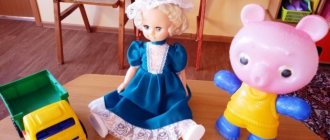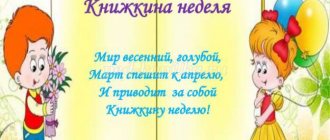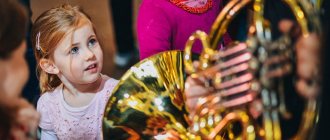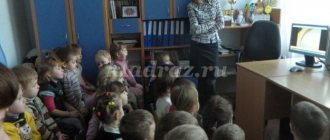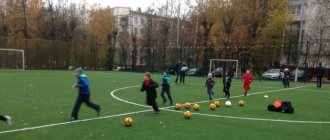Ecological week in kindergarten. Middle group
Project on the topic: “Environmental education of children of senior preschool age”
Ecological week “The Earth is our common home”
Goal: To consolidate and expand children’s knowledge about nature as an inexhaustible source of spiritual enrichment for people; awaken in children a keen interest and curiosity about the world around them; develop the child’s positive feelings towards nature. Objectives: — To form a system of basic environmental knowledge accessible to preschool children;
— Foster an emotionally positive, careful, caring attitude towards the natural world and the environment in general; — To develop skills in observing natural phenomena and objects. Monday
Excursion (walk) around the surroundings of the kindergarten.
Target:
Teach to notice changes occurring in nature, name the color of leaves, observe trees, understand what causes leaf fall, why insects have disappeared and birds fly away. Admire the beauty of autumn nature. Arouse interest in the world around you; to form a realistic idea of the nature around us; to develop skills in observing natural objects and phenomena. 1. Traveling around the world (looking at the globe; pay attention to the colors on the globe - water, land) 2. Making riddles about flora, fauna, insects. 3. Application on the theme: “Let’s decorate a scarf with a pattern of autumn leaves”
4. Examination of illustrations on the theme “Autumn in nature.” 5. . Game "Living - Nonliving." 6. Exercise “Color only the living.”
Tuesday
1. Recording bird observations in the observation calendar. Sorting material collected during walks. Making a herbarium. 2. Conversations in order to clarify ideas about the phenomena observed during walks. 3. Listening to “The Seasons” by P. I. Tchaikovsky and other music.
4. Reading and conversations after reading about the abilities of animals to adapt to their environment. 5. Making crafts from collected natural materials. Design from natural material on the theme: “Let’s put a butterfly on a flower”
6. Game “Review and Post.” Goal: To cultivate attention, patience, curiosity. 7. Printed board game “The sun is walking across the sky! Determine when this happens? 8. Conversation “This is not possible, but this is possible and necessary.” Discuss how to treat animals: sparrows, crows, cats, etc.
Wednesday
To consolidate children's knowledge about the phenomena of inanimate nature - water and its properties. Sun, air and water are our best friends. The arrival of “Aibolit” is a story about the healing powers of the sun and water (and the dangers). 1. Didactic game “Water is our helper” “Sorceress water” 2. Meeting of the “Why Chek” club. Topic: “Such different water” a) are all rains the same (spring, autumn, summer). b) are all clouds the same 4. Listening to the recording “The Sound of Rain” 5. Didactic game “What is the name of the chick?” 6. Ecological labor landing a) preparing a flower bed for the winter b) preparing seeds and leaves for the herbarium. 8. Solving riddles about the seasons. 9. Didactic game “Nest, hive, hole, or who lives where?”
Thursday
Poetry Day “Take care of the planet” 1. Exhibition of books about the planet. 2. Competition of readers about the animals of our forests (our forest zone (strip)) 3. Games “Guess the tree”, “Which tree is the leaf from? "(children make a “picture” from a set of small illustrations) 4. Reading Bianchi’s books: “Forest Houses” 5. . Memorizing poems about animals, plants, etc. 6. Improvisation of movements to the music of nature in an audio recording 7. Teacher's story about the behavior of birds and animals in the fall. 8. Didactic game - “What kind of wind?”
Friday
1. Entertainment for children on the topic: “Autumn walk” Purpose: To consolidate children’s knowledge about the seasons; autumn phenomena in nature. Expand knowledge about forest inhabitants in the autumn. Maintain interest in dance and music activities. 2. Competition of crafts made from natural materials for joint creativity between parents and children on the theme: “Look into the autumn forest” 3. Word game “Who has what fur coat?” 4. Work with parents: Final design of the exhibition on the theme: “Look into the autumn forest”
Walk-Monday
Cloud Observations.
Goals:
teach children to observe clouds, noting changes that occur; lead to the conclusion that cloudy weather is a characteristic sign of autumn.
Word game “Guess which tree the leaf comes from”
Didactic task:
determination of the distinctive features of leaves of maple, birch, rowan, etc.
Game action:
Find out and name the leaf corresponding to the tree.
Progress of the game
The teacher gives the children leaves of different shapes, and the children determine which tree they come from. — This leaf is from a birch tree, that’s why it’s called birch. — This leaf is from an oak tree, that’s why it’s called oak. - This leaf is from a rowan tree, that’s why it’s called rowan, etc.
Walk-Tuesday
Observing changes in nature: invite children to independently find signs of autumn in the surrounding nature.
Word game “Who has what fur coat?”
Didactic task:
Form coherent speech of a preschooler. Activate your vocabulary with words: fluffy, soft, smooth. Strengthen children's knowledge about animals.
Game action:
Guess the riddle about the animal proposed by the teacher and compose a descriptive story with the help of the teacher.
Progress of the game.
The teacher asks the children to guess a riddle about an animal. For example, What kind of forest animal is this? Stood up like a column under a pine tree. And stands among the grass - Are your ears bigger than your head? (Hare) After guessing the animal, the teacher encourages the children to remember and describe the appearance of the hare - What kind of fur coat does the bunny have? (white, fluffy, soft, etc.) - What kind of fur does the fox have? (red, soft, fluffy) - What kind of fur coat does the squirrel have? (soft, smooth)
Walk-Wednesday
Bird watching.
Target:
consolidate children's knowledge about birds - name, body parts, nutrition. Search and educational activity “Why do migratory birds leave us in the fall?” Goal: to help establish the dependence of the birds’ lifestyle on the lack of food during the cold season. Verbal exercise/game “Guess the riddle about the bird.”
Didactic task:
Exercise children in guessing riddles about birds. Fix the names of the birds: sparrow, tit, starling, crow.
Game action:
Listening and solving riddles. Finding the answer on cards with pictures of birds. (On a walk, you can do without cards; you can combine the game with a real bird and reward for the correct answer with pre-made birds using origami.)
Progress of the game.
The teacher asks the children riddles about birds. Little gray lump: Chik-chirk - he’s very cold! Sun, come out quickly! Who's waiting for warmth? (Sparrow) And in winter she can’t sit: She’s circling above my window, Asking for bread crumbs and wheat for breakfast... (Tit) The bird is chatty - no doubt, She’ll tell you news and secrets! Beautiful in appearance, white-sided Who? - Long-tailed... (magpie) - How can you call our guests in one word? Who is our guest? (Birds)
Walk – Thursday
Tree observations.
Target:
help children conclude that after the air temperature dropped below zero degrees (a noticeable cold snap), all the trees lost their leaves. Word game “Compare and tell how they differ?”
Didactic task:
To consolidate children's knowledge about the distinctive features of birds and animals.
Game rules:
Respond only when signaled by the teacher. Be able to listen to the opinions of your peers. Dialogue between the teacher and children using riddles about birds and animals, leading questions from the teacher to the children about the appearance and habits of animals and birds.
Progress of the game:
Using pictures of animals: fox, wolf, bear and hare. And birds: crow, sparrow, magpie. Children must find the differences and name them. (In older preschool age, the game is played in the fresh air, on a walk without pictures, the children act from memory and previous accumulated knowledge in the middle group) - How are birds and animals similar? (birds and animals have a body, eyes and a tail) - What do birds have that animals don’t? (birds have wings, but animals do not. Birds have a beak, and animals have a mouth. Birds have two legs, and animals have four. Birds have a body covered with wings, and animals have hair.
Walk – Friday
Wind observations.
Target:
To consolidate knowledge about the phenomena of inanimate nature. Determine the basic properties of wind. Bring children to the conclusion that wind is air movement that can have different strengths and directions. Word game “Which way is the wind blowing?”
Didactic task:
To consolidate children's knowledge about the phenomena of inanimate nature. Exercise in determining the basic properties of wind. Activate the speech of a preschooler. Develop observation and auditory attention.
Game action:
The teacher asks the children questions about what kind of wind is it today, what kind of wind can it be, what kind does it happen? Children use plumes or autumn leaves in their hands to determine the strength of the wind. (strong, gusty, cold, warm, autumn, etc.) Whoever answered the teacher’s question correctly, the first imitates the force of the wind.
Progress of the game.
The teacher invites the children to imagine a mental picture according to her words. — Clouds, rain, wind, tree branches sway, leaves turn yellow and fall to the ground, at what time of year does this happen (happens)? Children's answers: (in autumn). The teacher offers to sing a song of the autumn wind. - What wind? (strong, prickly, etc.) -But the wind began to subside. What wind is blowing now? (quiet) Note: The teacher can invite children to imagine a similar picture for another time of year, choosing words that highlight and define signs and natural phenomena of a particular time of year. (season) I bring to your attention a detailed description of the games that I used in the process of environmental education for children in the senior group throughout the entire project (one week) on environmental education. 1. Printed board game: “The sun is walking across the sky! Determine when this happens?
Didactic task:
To consolidate children's knowledge about the phenomena of inanimate nature: parts of the day.
Game rules:
Select colors according to the content of the text.
Game action:
Search for a card of a certain color based on the text content.
Didactic material:
colored cards. Model of a clock (a circle divided into four parts). Poetic texts about parts of the day.
Progress of the game.
As the teacher's story progresses, the children place the corresponding cards on the watch model. The sky suddenly turned pink, Quietly and timidly the Sun with a gentle ray What opened it like a key? (morning pink card) The sun shone brightly, the whole Earth was gilded. He shines and shines, doesn’t he tell us to be lazy? (day - yellow card) The sun has gone to bed, and as if He is covering the whole earth with a light blue blanket. Will the gnome read a fairy tale and quietly fall asleep? (evening-blue card) When did the Earth suddenly come together with the darkness, And in the sky did the moon come together with a star? Has the Dwarf been sleeping quietly for a long time? (at night - black card)
2. Didactic game with objects: “Water is our helper”
Didactic task:
To consolidate children's knowledge about the phenomena of inanimate nature - water and its properties.
Game rules:
Act only on a signal from the teacher. Select only those items that are necessary for the story and description. Maintain the order.
Game action:
Finding the right items.
Didactic material:
a basin with dirty laundry, soap and a toothbrush, a first aid kit with medicines; Pets; story card with a picture of a river, etc.
Progress of the game.
Children choose their favorite items on the table and give their explanations. — Residents of Flower City need water to wash their clothes. — Babies and toddlers need water to bathe and swim in the river. — Residents of the flower city need water to grow vegetables and fruits. — Doctor Pilyulkin needs water to make medicine and treat patients. — Cook Donut needs water to prepare lunches, breakfasts and dinners. — Shpuntik and Vintik need water to wash themselves after work. — All babies and toddlers need water to drink when it’s hot. Etc.
3. Game “Review and Post”
Didactic task:
To consolidate children's knowledge about the seasons and signs of autumn. Cultivate attention, curiosity, patience. Conduct basic comparative analysis, identify similarities and differences.
Game rules:
Act only on a signal from the teacher. Maintain the order.
Game action:
Children, at the teacher’s suggestion, lay out a color board on the “Seasons” clock. The main signs of autumn are laid out. Dialogue between teacher and children.
Didactic material:
“Seasons” clock, plot cards with signs of autumn according to the number of children.
Progress of the game
Children must identify and lay out on the table the main signs of autumn (another season). — What season should I set on our “Seasons” clock? (on the clock you need to set the hand to the season - autumn, the yellow part of the clock). -What time of year do I indicate to us the signs outside the window? (signs outside the window indicate to us that the time of year is autumn). -What signs of autumn did you put (address the girl or boy by name) on your table? (The sun in the sky has hidden behind a cloud, it is raining, there are puddles on the ground, a cold wind is blowing, the trees are without leaves, etc.)
4. Didactic game with objects “What is the name of the chick?”
Didactic task:
Exercise children in recognizing and naming birds: crow, sparrow, birdling, titmouse.
Game rules:
Children look at the figurine of a bird and its chick and answer the teacher’s question.
Didactic material:
figurines or pictures depicting birds and their chicks: baby crow; birdling starling; titmouse; little sparrow
Progress of the game:
The teacher shows a picture of a bird and its chick. The child must name the adult bird and its chick. - This is a sparrow, and the sparrow’s chick is a sparrow. Etc.
5. Didactic game “Nest, hive, hole, or who lives where?”
Note. Games can be played at any time of the day and used in various activities, at the discretion of the teacher. The rules of the games can also vary, which may depend on the creativity and resourcefulness of the teacher. The final stage of the environmental week was an event I developed - the “Autumn Quiz” entertainment. And also an exhibition-competition of crafts made from natural materials on the theme: “Look into the autumn forest.” Joint creativity of parents and children.
We recommend watching:
Abstract of educational activities on ecology in the senior group. Environmental education of children in kindergarten. Analytical report of a preschool educational institution on the organization of work. Section “Environmental education” Environmental project in kindergarten
Similar articles:
Scenario for an environmental event in kindergarten
Summary of educational activities for the development of environmental concepts in children of the senior group
Abstract of GCD on ecology in the preparatory school group
Ecology in music
Lesson summary on the topic “The Red Book” in the preparatory group
article “Forms and methods of work on environmental education in the middle group
Planting, sowing, and harvesting are carried out with children.
In a corner of nature, children examine plants and, together with the teacher, master the skills of caring for them.
5) Experimental search activities of children.
Experimental-search activity is understood as the joint work of the teacher and children, aimed at solving cognitive problems that arise in educational activities, in everyday life, in play and work, in the process of learning about the world. Search activity presupposes high activity and independence of children, the discovery of new knowledge and ways of knowing.
The search activity ends with an analysis of the results obtained during the inspection and the formulation of conclusions.
2. Methods of environmental education.
Teaching methods are ways of joint activities between the teacher and children, during which the formation of knowledge, abilities and skills, as well as attitudes towards the world around them, is carried out. In the middle group, various teaching methods are used: visual, practical, verbal.
Towards visual methods
include observation, examination of paintings, demonstration of models, films, filmstrips, and transparencies.
Practical methods -
This is a game, elementary experiments and simulation.
Verbal methods
- these are stories from the teacher and children, reading works of art about nature, conversations.
When working to introduce children to nature, it is necessary to use different methods in a complex and correctly combine them with each other.
1) Observation
Observation is a specially organized by the teacher, purposeful, more or less long-term and systematic, active perception by children of objects and natural phenomena. The purpose of observation can be the assimilation of various knowledge - establishing the properties and qualities, structure and external structure of objects, the reasons for the change and development of objects (plants, animals), seasonal phenomena.
.
The observation method in introducing children to nature is the main one. The need and significance of its use are associated, first of all, with the nature of the knowledge available to children of middle preschool age.
Observation allows children to show nature in natural conditions in all its diversity, in the simplest, clearly presented relationships. The systematic use of observation in getting to know nature teaches children to look closely, notice its features and leads to the development of observation, and therefore, the solution of one of the most important tasks of mental education.
Observation of nature is an inexhaustible source of aesthetic impressions and emotional impact on children. In the middle group, different types of observation are used. To form in children ideas about the diversity of plants and animals, objects of inanimate nature, recognition of the characteristics of certain objects, their properties, signs, recognizing observation is used. It ensures that children accumulate vivid, living knowledge about nature.
